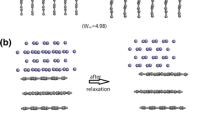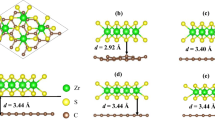Abstract
Density functional theory calculations including dispersion correction (DFT-D2) were used to investigate the relationship between charge distribution and nanofriction characteristics of graphene-based material systems. In our calculations, the single-side-hydrogenated graphene (SSHGraphene) system exhibits lower coefficient of friction, whereas the graphane system exhibits larger one compared with graphene system. These results are attributed to the adjustments of interfacial charge distribution that are induced by different hydrogen passivations. The charge distribution is smooth along the sliding direction for the SSHGraphene sheet, which yields a small potential barrier. Corrugation of the charge distribution in graphane system is much steeper than that in graphene system, which leads to a larger potential barrier. Comparative investigations reveal that the interfacial charge distributions determine the nanofriction performance, which may be helpful for friction modulation and design of new controlling lubricant material.









Similar content being viewed by others
References
Carpick, R.W.: Controlling friction. Science 313, 184–185 (2006)
Urbakh, M., Meyer, E.: The renaissance of friction. Nat. Mater. 9, 8–10 (2010)
Hirano, M.: Atomistics of friction. Surf. Sci. Rep. 60, 159–201 (2006)
Kim, H.-J., Kim, D.-E.: Nano-scale friction: a review. Int. J. Precis. Eng. Man. 10, 141–151 (2009)
Israelachvili, J.N.: Intermolecular and surface forces. Academic Press, London (1992)
Wang, J., Wang, F., Li, J., Sun, Q., Yuan, P., Jia, Y.: Comparative study of friction properties for hydrogen- and fluorine-modified diamond surfaces: a first-principles investigation. Surf. Sci. 608, 74–79 (2013)
Zilibotti, G., Righi, M.C.: Ab initio calculation of the adhesion and ideal shear strength of planar diamond interfaces with different atomic structure and hydrogen coverage. Langmuir 27, 6862–6867 (2011)
Bai, S., Onodera, T., Nagumo, R., Miura, R., Suzuki, A., Tsuboi, H., Hatakeyama, N., Takaba, H., Kubo, M., Miyamoto, A.: Friction reduction mechanism of hydrogen- and fluorine-terminated diamond–like carbon films investigated by molecular dynamics and quantum chemical calculation. J. Phys. Chem. C 116, 12559–12565 (2012)
Kwon, S., Ko, J.-H., Jeon, K.-J., Kim, Y.-H., Park, J.Y.: Enhanced nanoscale friction on fluorinated graphene. Nano Lett. 12, 6043–6048 (2012)
Wang, J., Wang, F., Li, J., Wang, S., Song, Y., Sun, Q., Jia, Y.: Theoretical study of superlow friction between two single–side–hydrogenated graphene sheets. Tribol. Lett. 48, 255–261 (2012)
Wang, L.-F., Ma, T.-B., Hu, Y.-Z., Wang, H., Shao, T.-M.: Ab initio study of the friction mechanism of fluorographene and graphane. J. Phys. Chem. C 117, 12520–12525 (2013)
Wang, L.-F., Ma, T.-B., Hu, Y.-Z., Wang, H.: Atomic-scale friction in graphene oxide: an interfacial interaction perspective from first-principles calculations. Phys. Rev. B 86, 125436 (2012)
Cahangirov, S., Ciraci, S., Özçelik, O.: Superlubricity through graphene multilayers between Ni (111) surfaces. Phys. Rev. B 87, 205428 (2013)
Velizhanin, K.A., Shahbazyan, T.V.: Long-range plasmon-assisted energy transfer over doped graphene. Phys. Rev. B 86, 245434 (2012)
Bollmann, W., Spreadborough, J.: Action of graphite as a lubricant. Nature 186, 29–30 (1960)
Wu, M., Cao, C., Jiang, J.Z.: Light non-metallic atom (B, N, O and F)-doped graphene: a first-principles study. Nanotechnology 21, 505202 (2010)
Son, Y.-W., Cohen, M.L., Louie, S.G.: Energy gaps in graphene nanoribbons. Phys. Rev. Lett. 97, 216803 (2006)
Kozlov, S.M., Viñes, F., Göling, A.: Bandgap engineering of graphene by physisorbed adsorbates. Adv. Mater. 23, 2638–2643 (2011)
Sofo, J.O., Chaudhari, A.S., Barber, G.D.: Graphane: a two-dimensional hydrocarbon. Phys. Rev. B 75, 153401 (2007)
Elias, D.C., Nair, R.R., Mohiuddin, T.M.G., Morozov, S.V., Blake, P., Halsall, M.P., Ferrari, A.C., Boukhvalov, D.W., Katsnelson, M.I., Geim, A.K., Novoselov, K.S.: Control of graphene’s properties by reversible hydrogenation: evidence for graphane. Science 323, 610–613 (2009)
Subrahmanyam, K.S., Kumar, P., Maitra, U., Govindaraj, A., Hembram, K.P.S.S., Waghmare, U.V., Rao, C.N.R.: Chemical storage of hydrogen in few-layer graphene. Proc. Natl. Acad. Sci. USA 108, 2674–2677 (2011)
Pujari, B.S., Gusarov, S., Brett, M., Kovalenko, A.: Single-side-hydrogenated graphene: density functional theory predictions. Phys. Rev. B. 84, 041402 (2011)
Ko, J.-H., Kwon, S., Byun, I.-S., Choi, J.S., Park, B.H., Kim, Y.-H., Park, J.Y.: Nanotribological properties of fluorinated, hydrogenated, and oxidized graphenes. Tribol. Lett. 50, 137–144 (2013)
Dong, Y., Wu, X., Martini, A.: Atomic roughness enhanced friction on hydrogenated graphene. Nanotechnology 24, 375701 (2013)
Kress, G., Furthmüller, J.: Efficient iterative schemes for ab initio total-energy calculations using a plane-wave basis set. Phys. Rev. B 54, 11169–11186 (1996)
Blöchl, P.E.: Projector augmented-wave method. Phys. Rev. B 50, 17953–17979 (1994)
Kresse, G., Joubert, D.: From ultrasoft pseudopotentials to the projector augmented-wave method. Phys. Rev. B. 59, 1758–1775 (1998)
Perdew, J.P., Burke, K., Ernzerhof, M.: Generalized gradient approximation made simple. Phys. Rev. Lett. 77, 3865–3868 (1996)
Grimme, S.: Semiempirical GGA-type density functional constructed with a long-range dispersion correction. J. Comput. Chem. 27, 1787–1799 (2006)
Bučko, T., Hafner, J., Lebègue, S., Ángván, J.G.: Improved description of the structure of molecular and layered crystals: ab initio DFT calculations with van der Waals corrections. J. Phys. Chem. A 114, 11814–11824 (2010)
Monkhorst, H.J., Pack, J.D.: Special points for Brillouin-zone integrations. Phys. Rev. B 13, 5188–5192 (1976)
Zhong, W., Tománek, D.: First-principles theory of atomic-scale friction. Phys. Rev. Lett. 64, 3054–3057 (1990)
Neitola, R., Pakkanen, T.A.: Ab initio studies on the atomic-scale origin of friction between hydrocarbon layers. Chem. Phys. 299, 47–56 (2004)
Neitola, R., Pakkanen, T.A.: Ab initio studies on the atomic-scale origin of friction between diamond (111) surfaces. J. Phys. Chem. B 105, 1338–1343 (2001)
Koskilinna, J.O., Linnolathi, M., Pakkanen, T.A.: Friction coefficient for hexagonal boron nitride surfaces from ab initio calculations. Tribol. Lett. 24, 37–41 (2006)
Dienwiebel, M., Verhoeven, G.S., Pradeep, N., Frenken, J.W.M., Heimberg, J.A., Zandbergen, H.W.: Superlubricity of graphite. Phys. Rev. Lett. 92, 126101 (2004)
Neitola, R., Ruuska, H., Pakkanen, T.A.: Ab initio studies on nanoscale friction between graphite layers: effect of model size and level of theory. J. Phys. Chem. B 109, 10348–10354 (2005)
Fessler, G., Eren, B., Gysin, U., Glatzel, T., Meyer, E.: Friction force microscopy studies on SiO2 supported pristine and hydrogenated graphene. Appl. Phys. Lett. 104, 041910 (2014)
Acknowledgments
The work was supported by Key Basic Research Project of China (Grant No. 2012CB921300), National Natural Science Foundation of China (Grant No. 11274280), Natural Science Foundation of Henan Province (Grant No. 142300410250), and Foundation of Henan Educational Committee (Grant No. 14A140025).
Author information
Authors and Affiliations
Corresponding authors
Rights and permissions
About this article
Cite this article
Wang, J., Li, J., Fang, L. et al. Charge Distribution View: Large Difference in Friction Performance Between Graphene and Hydrogenated Graphene Systems. Tribol Lett 55, 405–412 (2014). https://doi.org/10.1007/s11249-014-0370-8
Received:
Accepted:
Published:
Issue Date:
DOI: https://doi.org/10.1007/s11249-014-0370-8




